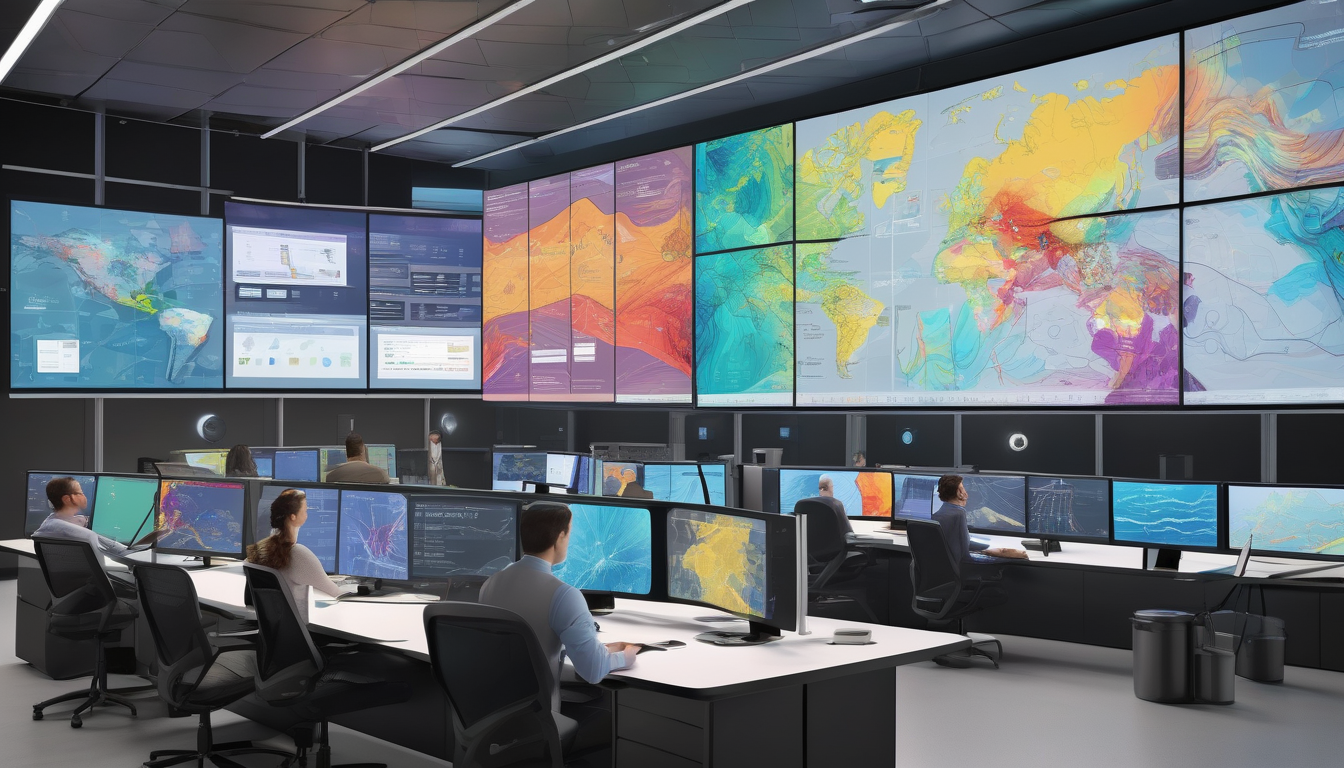Climate change is not just a buzzword; it’s a pressing reality that demands immediate action. In this chaotic race against time, artificial intelligence (AI) emerges as a powerful ally, transforming how we approach environmental sustainability. Imagine AI as a superhero, equipped with the ability to analyze vast amounts of data, optimize energy usage, and even predict future climate scenarios. With its innovative applications, AI is reshaping the landscape of climate change mitigation.
One of the most significant contributions of AI lies in its data analysis capabilities. Traditional methods of analyzing climate data can be slow and cumbersome. However, AI can swiftly process large datasets, providing insights that were previously out of reach. This ability allows researchers and policymakers to make informed decisions about climate action strategies. For instance, AI can identify patterns in climate data, helping to forecast extreme weather events and their potential impacts on communities.
Moreover, AI plays a crucial role in smart energy management. By optimizing energy consumption and production, it helps reduce greenhouse gas emissions. Think of smart grids powered by AI as a conductor leading an orchestra, ensuring that every instrument plays in harmony. These systems not only enhance energy efficiency but also facilitate the integration of renewable energy sources, which is vital for a sustainable future.
As cities grow, so do the challenges they face. AI assists in urban planning by analyzing data on traffic, pollution, and resource use. This allows city planners to create smarter, greener environments that are more resilient to climate impacts. By leveraging AI, we can design urban spaces that not only meet the needs of their inhabitants but also contribute to the overall health of our planet.
In summary, the role of AI in combating climate change is multifaceted and dynamic. From enhancing data analysis to optimizing energy management and urban planning, AI is paving the way for a sustainable future. As we harness this technology, we must remain vigilant and proactive, ensuring that our efforts lead to meaningful change for generations to come.

AI-Powered Data Analysis
Artificial intelligence is revolutionizing the way we analyze data, particularly in the context of climate change. Imagine having a super-smart assistant that can sift through mountains of information in seconds, picking out the most relevant details to help us understand our planet’s changing climate. This is exactly what AI does! By processing vast datasets from various sources such as satellite imagery, weather stations, and ocean buoys, AI can identify patterns and trends that would take humans an eternity to uncover.
One of the most exciting aspects of AI-powered data analysis is its ability to enhance predictive capabilities. For instance, AI algorithms can forecast extreme weather events by analyzing historical data and current conditions. This not only helps in preparing for disasters but also informs policy decisions that can mitigate the impacts of climate change. With the help of AI, we can move from reactive to proactive measures in our climate strategies.
Furthermore, AI’s efficiency in processing data allows for real-time analysis, which is crucial in our fast-paced world. For example, during a natural disaster, AI can quickly analyze data from various sources to provide timely updates and recommendations. This can be a game-changer in saving lives and protecting communities.
To illustrate the impact of AI in climate data analysis, consider the following table, which highlights key applications:
| Application | Description | Impact |
|---|---|---|
| Weather Prediction | Using AI to analyze atmospheric data for accurate forecasts. | Improved disaster preparedness and response. |
| Carbon Emission Tracking | Monitoring emissions from various sectors using AI analytics. | Informed policy-making for emission reduction. |
| Biodiversity Monitoring | Using AI to analyze species data and habitat conditions. | Enhanced conservation efforts. |
In summary, AI-powered data analysis is not just a technological advancement; it’s a crucial ally in our fight against climate change. By harnessing the power of AI, we can make informed decisions that lead to sustainable solutions, ultimately paving the way for a healthier planet.

Smart Energy Management
In today’s fast-paced world, is not just a luxury; it’s a necessity. With the growing concern over climate change and the urgent need to reduce greenhouse gas emissions, artificial intelligence (AI) is stepping in as a game changer. Imagine a world where energy consumption is optimized, waste is minimized, and our reliance on fossil fuels is significantly reduced. Sounds like a dream, right? Well, AI is turning that dream into reality.
AI technologies are revolutionizing how we consume and produce energy. By analyzing vast amounts of data, these systems can identify patterns and trends that were previously invisible to human analysts. For instance, smart grids powered by AI can adjust energy distribution in real-time based on demand, ensuring that energy is used efficiently. This not only saves money but also reduces the carbon footprint of energy consumption.
Furthermore, AI plays a pivotal role in the integration of renewable energy sources. With the unpredictability of wind and solar power, AI algorithms can forecast energy production and consumption, ensuring a balanced energy supply. This means that when the sun is shining or the wind is blowing, AI can maximize the use of these renewable sources, reducing reliance on traditional energy sources.
To illustrate the impact of AI on energy management, consider the following table:
| AI Application | Benefit |
|---|---|
| Smart Grids | Real-time energy distribution and consumption optimization |
| Predictive Maintenance | Increased efficiency and lifespan of renewable systems |
| Energy Storage Optimization | Maximized use of renewable energy, reduced fossil fuel reliance |
In addition to optimizing energy use, AI also enhances predictive maintenance for renewable energy systems. By predicting when equipment like wind turbines and solar panels need servicing, AI ensures they operate at peak efficiency. This proactive approach not only extends the life of these systems but also contributes to overall climate mitigation efforts. As we continue to explore the capabilities of AI in energy management, the potential for a sustainable future becomes increasingly tangible.
Renewable Energy Integration
Integrating renewable energy sources into existing power systems is not just a trend; it’s a necessity for a sustainable future. With the world grappling with the effects of climate change, the need for cleaner energy solutions has never been more urgent. Artificial Intelligence (AI) plays a pivotal role in this integration, acting as the bridge that connects traditional energy grids with renewable sources like solar, wind, and hydroelectric power.
One of the primary challenges in renewable energy integration is the intermittency of sources. For instance, solar energy production peaks during sunny days, while wind energy is dependent on weather conditions. AI tackles this challenge head-on by utilizing sophisticated algorithms that analyze historical and real-time data to forecast energy production and consumption patterns. This capability ensures that energy supply remains balanced and reliable, even when the sun isn’t shining or the wind isn’t blowing.
Moreover, AI enhances grid management through the development of smart grids. These grids leverage AI to optimize the distribution of energy, improve efficiency, and reduce waste. By analyzing data from various sources, AI can predict demand spikes and adjust energy distribution accordingly. This not only minimizes the risk of blackouts but also maximizes the use of renewable resources.
To illustrate the impact of AI on renewable energy integration, consider the following table:
| AI Application | Impact on Renewable Energy |
|---|---|
| Energy Forecasting | Improves accuracy in predicting energy supply and demand. |
| Grid Optimization | Enhances efficiency in energy distribution and reduces losses. |
| Storage Management | Optimizes the use of battery storage systems, ensuring energy availability. |
In conclusion, renewable energy integration powered by AI is not just about adopting new technologies; it’s about reshaping our entire approach to energy management. By leveraging AI’s capabilities, we can create a more sustainable and resilient energy future that not only meets our current needs but also protects our planet for generations to come.
Predictive Maintenance for Renewable Systems
Imagine a world where wind turbines and solar panels operate at peak efficiency without constant human oversight. Predictive maintenance powered by artificial intelligence is turning this dream into reality. By utilizing advanced algorithms, AI can analyze data from renewable energy systems to predict when maintenance is necessary, thereby preventing unexpected failures and costly downtimes.
This proactive approach is akin to having a personal trainer for your renewable energy systems—always assessing performance and suggesting improvements. For example, AI can monitor vibration patterns in wind turbines or the performance metrics of solar panels, identifying anomalies that may indicate wear and tear. When these issues are detected early, operators can schedule maintenance before a minor issue escalates into a major problem.
Furthermore, the benefits of predictive maintenance extend beyond just operational efficiency. By enhancing the lifespan of renewable systems, we can significantly reduce the environmental impact associated with manufacturing and disposing of equipment. This leads to a more sustainable approach to energy production, aligning perfectly with global climate goals.
To illustrate the impact of predictive maintenance, consider the following table:
| System Type | Maintenance Frequency (Traditional) | Maintenance Frequency (Predictive) | Cost Savings |
|---|---|---|---|
| Wind Turbines | Monthly | Quarterly | 30% |
| Solar Panels | Bi-Annually | Annually | 25% |
In summary, predictive maintenance not only enhances the operational efficiency of renewable systems but also contributes significantly to their sustainability. It’s a win-win scenario where technology meets environmental responsibility, paving the way for a greener future.
Energy Storage Optimization
Energy storage optimization is a game changer in the quest for a sustainable future. With the rise of renewable energy sources like solar and wind, the challenge lies in effectively storing this energy for when we need it most. Imagine a world where your energy supply is as reliable as your morning coffee—always there, always ready. This is where artificial intelligence (AI) steps in, transforming how we manage energy storage.
AI algorithms analyze vast amounts of data to determine the most efficient ways to store energy. For instance, they can predict energy demand and supply fluctuations, helping to optimize battery systems. This means that when the sun is shining brightly or the wind is blowing hard, AI can direct excess energy into storage systems, ensuring that we maximize our renewable energy usage. The result? A significant reduction in reliance on fossil fuels and a smaller carbon footprint.
Moreover, AI enhances the lifespan and efficiency of energy storage systems. By predicting when maintenance is needed, AI ensures that batteries and other storage technologies operate at peak performance. Think of it as having a personal trainer for your energy systems—always monitoring, always optimizing. This proactive approach not only saves costs but also boosts overall energy reliability.
To illustrate the impact of AI on energy storage optimization, consider the following table:
| AI Application | Benefit |
|---|---|
| Demand Forecasting | Ensures energy supply meets consumer needs |
| Battery Health Monitoring | Extends battery lifespan and efficiency |
| Load Balancing | Optimizes energy distribution across the grid |
In summary, energy storage optimization through AI is not just a technological advancement; it’s a vital part of the solution to climate change. By harnessing the power of AI, we can create a more resilient energy system that not only meets today’s demands but also paves the way for a greener tomorrow. So, the next time you flip a switch, remember the silent hero working behind the scenes: AI.
Urban Planning and Sustainability
In today’s rapidly urbanizing world, the role of artificial intelligence in urban planning and sustainability cannot be overstated. Cities are evolving at an unprecedented pace, and with this growth comes a myriad of challenges, such as traffic congestion, pollution, and resource management. AI offers innovative solutions to help cities become more sustainable and livable.
One of the most exciting applications of AI in urban planning is its ability to analyze vast amounts of data to inform decision-making. By processing information from various sources—like traffic cameras, weather data, and social media—AI can identify patterns and trends that human planners might overlook. This data-driven approach allows for more effective resource allocation and better urban design.
Consider, for example, how AI can optimize traffic flow. By analyzing real-time traffic data, AI systems can adjust traffic signals dynamically, reducing congestion and lowering emissions. Imagine a city where traffic lights communicate with vehicles, ensuring smooth travel without unnecessary stops. This is not just a dream; it’s becoming a reality thanks to AI technology.
Moreover, AI plays a crucial role in enhancing public transportation systems. With predictive analytics, cities can forecast demand, ensuring that buses and trains are available when and where they are needed most. This not only improves the efficiency of public transit but also encourages more people to use it, reducing reliance on personal vehicles and further cutting down emissions.
Furthermore, AI can assist in green space management. By analyzing environmental data, cities can identify areas that require more greenery, helping to improve air quality and provide residents with recreational spaces. This holistic approach to urban planning fosters a healthier environment and enhances the quality of life for city dwellers.
In conclusion, the integration of AI in urban planning is paving the way for smarter, more sustainable cities. As we continue to harness the power of technology, we can address the pressing challenges of urbanization and create a future that is not only efficient but also environmentally friendly.

Climate Modeling and Simulation
Climate modeling and simulation are at the forefront of understanding our planet’s future, and artificial intelligence is revolutionizing this field. By leveraging advanced algorithms, AI enhances the accuracy of climate models, allowing scientists to predict potential climate scenarios with greater precision. Imagine trying to navigate a ship through a stormy sea without a map—this is how vital accurate climate models are for policymakers and environmentalists alike.
AI’s ability to process vast amounts of data from various sources, including satellite imagery and historical climate records, enables researchers to identify trends and patterns that would be impossible to discern manually. For instance, machine learning algorithms can analyze temperature fluctuations, sea level changes, and greenhouse gas concentrations, creating a comprehensive picture of our planet’s health. This data-driven approach not only informs climate policy but also empowers communities to take proactive measures against climate change.
One of the exciting aspects of AI in climate modeling is its capability for real-time simulations. Unlike traditional models that may take weeks or months to produce results, AI can generate insights almost instantaneously. This rapid processing is crucial during climate emergencies, allowing for swift decision-making and response. For example, when a natural disaster strikes, AI can help predict its trajectory, enabling timely evacuations and resource allocation.
| AI Applications in Climate Modeling | Benefits |
|---|---|
| Data Analysis | Identifies trends and anomalies in climate data |
| Predictive Analytics | Forecasts potential climate scenarios |
| Real-Time Monitoring | Facilitates immediate responses to environmental changes |
In conclusion, the integration of AI into climate modeling and simulation is not just a technological advancement; it is a game-changer in our fight against climate change. By providing accurate predictions and enabling informed decisions, AI is helping to pave the way for a more sustainable future. So, as we look ahead, we must embrace these innovations and harness their potential to protect our planet for generations to come.
Machine Learning in Climate Science
Machine learning is revolutionizing the field of climate science, acting like a powerful magnifying glass that helps researchers uncover hidden patterns within vast datasets. Imagine trying to find a needle in a haystack; that’s what scientists faced before the advent of machine learning. Now, with advanced algorithms, they can sift through mountains of climate data to identify trends that were previously invisible.
One of the most exciting applications of machine learning is its ability to predict climate-related events. By analyzing historical data, machine learning models can forecast phenomena such as extreme weather events, droughts, and floods. This predictive power is crucial for developing effective climate policies and preparing communities to respond to these challenges. For instance, researchers can use machine learning to predict the likelihood of a hurricane hitting a coastal area, allowing for timely evacuations and resource allocation.
Moreover, machine learning enhances the accuracy of climate models. Traditional models often rely on simplified assumptions that may not capture the complexities of our climate system. However, machine learning can analyze real-time data from various sources, such as satellite imagery and ground sensors, to create more nuanced models. This allows for a deeper understanding of how different factors—like greenhouse gas emissions and deforestation—interact to influence climate change.
To illustrate the impact of machine learning in climate science, consider the following table:
| Application | Description | Impact |
|---|---|---|
| Event Prediction | Forecasting extreme weather events using historical data. | Improved preparedness and disaster response. |
| Model Accuracy | Enhancing climate models with real-time data analysis. | Better policy-making and resource management. |
| Trend Analysis | Identifying long-term climate trends and patterns. | Informed public awareness and education. |
In summary, machine learning is not just a tool; it’s a game changer in the fight against climate change. By harnessing its capabilities, we can better understand the intricate dynamics of our planet’s climate system and take more informed actions to mitigate its impacts. The future of climate science is bright, thanks to the innovations brought forth by machine learning.
Real-Time Monitoring and Response
In the age of climate change, the ability to respond swiftly to environmental shifts is more critical than ever. Artificial Intelligence (AI) plays a pivotal role in real-time monitoring, effectively acting as our eyes and ears in the ecosystem. Imagine having a vigilant guardian that never sleeps, constantly analyzing data streams from various sources, such as satellites, sensors, and weather stations. This capability allows us to detect changes in the environment almost instantaneously.
For instance, AI algorithms can process vast amounts of data to identify patterns that indicate impending natural disasters, such as floods or wildfires. By leveraging machine learning, these systems can learn from historical data and improve their predictive accuracy over time. This is akin to having a seasoned meteorologist who not only understands the weather but can also foresee its impact on our communities.
Moreover, real-time monitoring systems powered by AI can alert authorities and communities about potential threats. This is crucial for minimizing damage and enhancing preparedness. For example, if a sudden spike in temperature is detected in a region prone to wildfires, AI can trigger early warnings, allowing residents to evacuate and emergency services to mobilize. Such proactive measures can save lives and significantly reduce property damage.
Additionally, the integration of AI in environmental monitoring extends beyond just disaster response. It enables continuous tracking of air quality, water levels, and biodiversity. This data is invaluable for policymakers and researchers who are striving to create effective climate action plans. Here’s a quick look at some of the benefits:
- Enhanced Decision-Making: Real-time data allows for informed decisions that can mitigate environmental impacts.
- Cost Efficiency: Early detection of issues can lead to lower costs in disaster management and recovery.
- Community Engagement: Real-time updates can empower communities to take action and stay informed about their environment.
In conclusion, the role of AI in real-time monitoring and response is not just a technological advancement; it is a necessary evolution in our fight against climate change. By harnessing the power of AI, we can better protect our planet and ensure a sustainable future for generations to come.
Frequently Asked Questions
- How does AI help in climate change mitigation?
AI plays a crucial role by analyzing vast amounts of data to identify trends and patterns in climate change. This helps in making informed decisions about climate action strategies and optimizing resource use.
- What are smart energy management systems?
Smart energy management systems utilize AI to optimize energy production and consumption. They help reduce greenhouse gas emissions by improving energy efficiency and integrating renewable energy sources more effectively.
- Can AI predict maintenance needs for renewable energy systems?
Absolutely! AI can analyze performance data and predict when maintenance is needed for systems like solar panels and wind turbines, ensuring they operate efficiently and have a longer lifespan.
- How does AI contribute to urban planning?
AI assists urban planners by analyzing data related to traffic, pollution, and resource usage. This leads to the creation of smarter, more sustainable cities that minimize environmental impact.
- What is the role of machine learning in climate science?
Machine learning algorithms help climate scientists analyze complex datasets, revealing trends that can inform policies and action plans aimed at mitigating climate change effects.
- How does AI enable real-time environmental monitoring?
AI technologies facilitate real-time monitoring of environmental changes, allowing for quick responses to climate-related events, which helps reduce their impact on ecosystems and communities.



